当前位置:
X-MOL 学术
›
Adv. Opt. Mater.
›
论文详情
Our official English website, www.x-mol.net, welcomes your
feedback! (Note: you will need to create a separate account there.)
NIR‐II/III Luminescence Ratiometric Nanothermometry with Phonon‐Tuned Sensitivity
Advanced Optical Materials ( IF 8.0 ) Pub Date : 2020-01-09 , DOI: 10.1002/adom.201901173 Mochen Jia 1 , Zuoling Fu 1 , Guofeng Liu 1 , Zhen Sun 1 , Panpan Li 1 , Anqi Zhang 1 , Fang Lin 1 , Bofei Hou 1 , Guanying Chen 2
Advanced Optical Materials ( IF 8.0 ) Pub Date : 2020-01-09 , DOI: 10.1002/adom.201901173 Mochen Jia 1 , Zuoling Fu 1 , Guofeng Liu 1 , Zhen Sun 1 , Panpan Li 1 , Anqi Zhang 1 , Fang Lin 1 , Bofei Hou 1 , Guanying Chen 2
Affiliation

|
Luminescence nanothermometers are promising for noninvasive, high resolution thermographics ranging from aeronautics to biomedicine. Yet, limited success has been met in the NIR‐II/III biological windows, which allow temperature evaluation in deep tissues. Herein, a new type of phonon‐based ratiometric thermometry is described that utilizes the luminescence intensity ratio (LIR) between holmium (Ho3+) emission at ≈1190 nm (NIR‐II) and erbium (Er3+) emission at ≈1550 nm (NIR‐III) from a set of oxide nanoparticles of varying host lattices. It is shown that multi‐phonon relaxation in Er3+ ions and phonon‐assisted transfer process in Ho3+ ions play a significant role in LIR determination through channeling the harvested excitation energy to the corresponding emitting states. As a result, temperature sensitivity can be tuned by the dominant phonon energy of host lattice, thus endowing aqueous yttrium oxide (Y2O3, 376 cm−1) nanoparticles to have a relative temperature sensitivity of 1.01% K−1 and absolute temperature sensitivity of 0.0127 K−1 at 65 °C in a physiological temperature range (25–65 °C). And their temperature sensing for biological tissues is further explored and the influence of water and chicken breast on thermometry is discussed. This work constitutes a solid step forward to build sensitive NIR‐II/III nanothermometers for biological applications.
中文翻译:

具有声子调谐灵敏度的NIR-II / III发光比率测热法
发光纳米温度计有望用于从航空到生物医学的非侵入性高分辨率热成像。但是,在NIR-II / III生物窗口中只能取得有限的成功,该窗口可以评估深层组织的温度。在此,我们描述了一种新型的基于声子的比率式测温法,该方法利用了≈1190nm的(Ho 3+)发射(NIR-II)和≈1550的(Er 3+)发射之间的发光强度比(LIR)纳米(NIR-III)来自一组具有不同主体晶格的氧化物纳米粒子。结果表明,Er 3+离子中的多声子弛豫和Ho 3+中的声子辅助转移过程。离子通过将收获的激发能引导到相应的发射态,在LIR测定中发挥重要作用。其结果是,温度敏感性可以通过主晶格的主导声子能量被调谐,从而赋予含水氧化钇(Y 2 ö 3, 376厘米-1)纳米粒子具有1.01%K的相对温度敏感性-1和绝对温度灵敏度为0.0127 K -1在65°C的生理温度范围(25–65°C)中。并进一步探讨了它们对生物组织的温度感应,并讨论了水和鸡胸肉对体温测定的影响。这项工作为构建用于生物应用的敏感NIR-II / III纳米温度计迈出了坚实的一步。
更新日期:2020-03-20
中文翻译:

具有声子调谐灵敏度的NIR-II / III发光比率测热法
发光纳米温度计有望用于从航空到生物医学的非侵入性高分辨率热成像。但是,在NIR-II / III生物窗口中只能取得有限的成功,该窗口可以评估深层组织的温度。在此,我们描述了一种新型的基于声子的比率式测温法,该方法利用了≈1190nm的(Ho 3+)发射(NIR-II)和≈1550的(Er 3+)发射之间的发光强度比(LIR)纳米(NIR-III)来自一组具有不同主体晶格的氧化物纳米粒子。结果表明,Er 3+离子中的多声子弛豫和Ho 3+中的声子辅助转移过程。离子通过将收获的激发能引导到相应的发射态,在LIR测定中发挥重要作用。其结果是,温度敏感性可以通过主晶格的主导声子能量被调谐,从而赋予含水氧化钇(Y 2 ö 3, 376厘米-1)纳米粒子具有1.01%K的相对温度敏感性-1和绝对温度灵敏度为0.0127 K -1在65°C的生理温度范围(25–65°C)中。并进一步探讨了它们对生物组织的温度感应,并讨论了水和鸡胸肉对体温测定的影响。这项工作为构建用于生物应用的敏感NIR-II / III纳米温度计迈出了坚实的一步。










































 京公网安备 11010802027423号
京公网安备 11010802027423号